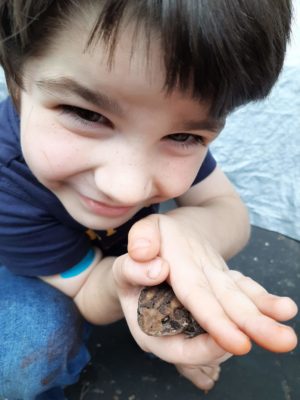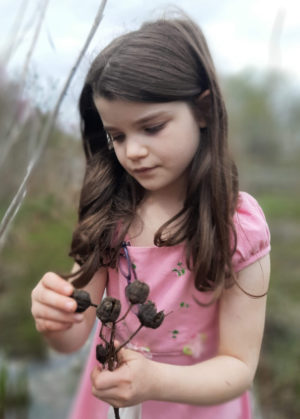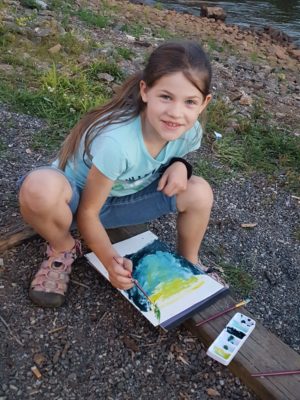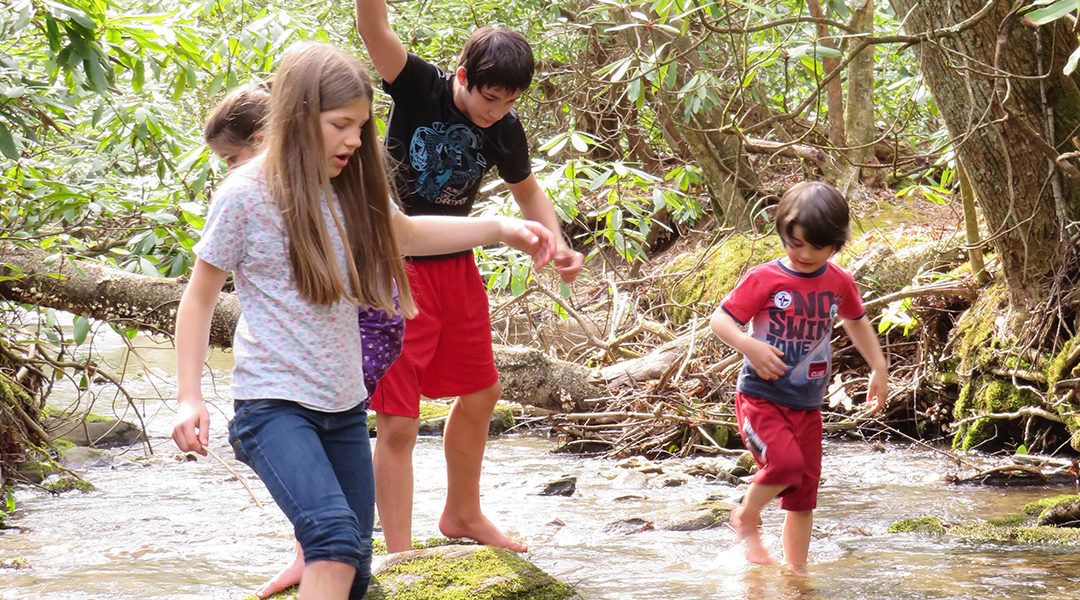Spring 2022/Jessica Frierson
If your children are anything like mine, they love to spend time outdoors. Rain or shine, cold and snowy (especially snowy!) or warm and dry, they can’t wait to run outside. If they aren’t outdoors, there’s a good chance they can be found at a window watching one of our bird feeders, on the lookout for the coyotes they hear howling, or laughing at the antics of a couple of mischievous squirrels. Our house is full of bowls of rocks they’ve collected, insect specimens that have been preserved, sea shells gathered from a beach trip, and a hodgepodge of acorns, pine cones, bird feathers, leaves, and even animal bones.
 I share their love of nature and strive to inspire it so they can reap the many benefits I believe God endows to us through interaction with His amazing creations. The sense of awe one feels at the wonders of nature helps us recognize God’s sovereignty and majesty. His rebuke in Job 38 is an important reminder of our rightful perspective of our place in this world: “Who shut up the sea behind doors when it burst forth from the womb, when I made the clouds its garment and wrapped it in thick darkness? When I fixed limits for it and set its doors and bars in place, when I said, ‘This far you may come and no farther; here is where your proud waves halt’?” (Job 38:8-11).
I share their love of nature and strive to inspire it so they can reap the many benefits I believe God endows to us through interaction with His amazing creations. The sense of awe one feels at the wonders of nature helps us recognize God’s sovereignty and majesty. His rebuke in Job 38 is an important reminder of our rightful perspective of our place in this world: “Who shut up the sea behind doors when it burst forth from the womb, when I made the clouds its garment and wrapped it in thick darkness? When I fixed limits for it and set its doors and bars in place, when I said, ‘This far you may come and no farther; here is where your proud waves halt’?” (Job 38:8-11).
As we behold the breaking of dawn or the close of the day, we observe the power He holds over things we can only look upon. “The heavens declare the glory of God; the skies proclaim the work of His hands. Day after day they pour forth speech; night after night they display knowledge” (Psalm 19:1-2).
Robert Browning writes, “God is seen in the star, in the stone, in the flesh, in the soul and the clod.” 1
“The power that holds the sky’s majesty wins our worship,” notes the ancient Greek tragedian Aeschylus.
I have discovered that an abundance of research supports the vast ways that spending time outdoors enhances our lives in ways beyond directing our spiritual focus. The positive effects of being out in nature with our children, whether in the middle of the Great Smoky Mountains National Park or in their backyard, last into adulthood.
Physical
Many a harried mother has sent her rowdy children outdoors to let out some of that energy. Although her motives may have partially been selfish, the results achieved are rewarding to all. To state the obvious: children can play outdoors differently than they can inside. Not only does this serve to keep our windows and furniture intact, it also gives them an opportunity to work on whole-body movement and develop better spatial awareness.
Studies indicate that the more time children spend outdoors, the greater the impact on their overall health. They are less likely to be asthmatic. Fresh air is invigorating, and exposure to sunlight helps them build up their bodies’ stores of vitamin D, which aids in bone development, healthy sleep, and a strong immune system. They can burn more calories, are less likely to be overweight, and are more likely to develop habits that promote physical wellness that will help them maintain healthy lifestyles as adults. Exercise activities performed in a natural environment are more likely to be repeated than the same activity performed indoors and have been shown to lower cortisol levels, which play a role in nearly every bodily system. Outdoor play also increases alertness and decreases restlessness. So our motherly intuition is correct—open the door and shoo them out!
 Emotional/Mental
Emotional/Mental
Besides the beneficial physical influences on our bodies, time spent in nature has been proven to positively affect our emotional and mental health. It is calming and aids both concentration and attentiveness. It decreases aggression, stress, and depression.2 A 2019 study carried out by European researchers showed that “adults who had low levels of natural outdoor environments in their childhood had significantly worse mental health than those who were exposed to nature.”3 Just twenty minutes spent in nature improves concentration and can reduce the need for ADHD/ADD medication while helping better focus. Additionally, “an aesthetic awareness of an emotional link to the…natural world is a crucial component of human wellbeing.”4
As parents, it can be challenging to find the balance between our desire to protect our children from the many risks they will encounter in life, yet also prepare them to face obstacles that are inevitable. Playing outdoors offers many opportunities for children to learn risk-taking skills and develop resilience. The executive function skills that “help us plan, prioritize, troubleshoot, negotiate, and multitask” as well as “us[e] our imagination to problem-solve and entertain [our]selves”5 are honed as children spend unstructured time in the free-flowing, ever-changing natural world outdoors. Something as seemingly simple as playing in a mountain stream offers experiences for them to take risks, discover new strategies through failure, and gain confidence in their successes as they skip rocks, jump from boulder to boulder, and balance on a fallen log.
Have you ever wondered why children have so much fun digging holes in the backyard or splashing in mud puddles? Scientists have discovered bacterial microbes in good, old-fashioned dirt which boost our serotonin levels!6 “Mycobacterium vaccae in the soil has a profound effect on neurons in the human body, which makes you happy.”
And dirt isn’t the only aspect of nature that makes us happy. According to the U.S. National Park Service, “listening to birdsongs and observing animals in nature have shown to promote wellbeing, reduce stress, improve mood, and reduce attention fatigue. Natural aromas from wood and plants have calming effects and viewing nature reduces mental fatigue.” In fact, as my children have often demonstrated, “views of nature…increase direct attention, well-being, and life satisfaction. They also increase working memory and concentration.”7
“When you look out at a green landscape—even from indoors—your heart rate will go down, and you’ll change from sympathetic nervous activity over to parasympathetic nervous activity, which is basically going from what we call ‘fight or flight’ into ‘tend and befriend’ mode,” observed Dr. Ming Kuo, associate professor in the Department of Natural Resources and Environmental Sciences and director of the Landscape and Human Health Lab at the University of Illinois at Urbana-Champaign, on a recent episode of NPR’s Hidden Brain.
Social
This change from “fight or flight” mode to “tend and befriend mode” has been observed in the manner in which children form friendships while playing together on a playground versus in nature. Friendships formed in a forest or a field tend to be based on inventiveness and resourcefulness instead of physical prowess.8 Playmates collaborate to create games and rules, solve their own problems without inhibition, and have a greater propensity for empathy for others.9 Interaction with smaller, often more delicate, living things helps children develop empathy and care for others.
Sensing a butterfly flutter by their head or spying a deer at the edge of the woods will cause the most boisterous child to slow down and focus on being gentle. Spending time outdoors often involves planting and becoming caretakers. They have a firsthand observation of the life cycle, seeing that things grow and that they die. During a recent snowstorm, my two youngest, ages six and nine, expressed concern for the birds they saw attempting to find food buried under ice and snow. They hurriedly donned their coats and boots to fill the suet feeder with a new cake and experiment with finding a way to set out bird seed where it could be easily accessed.
As children learn to care for living things and their habitats, they develop a sense of connection to the physical, natural, and human world that leads to an awareness that they belong to something bigger than their immediate family or surroundings. They begin to understand the need to work together with others and grow in the ministry of servanthood. They see the importance of community. Their growing appreciation for clean water, fresh air, natural habitats, and green spaces helps them see the necessity for good stewardship of those things. As noted by Harvard Health, “If a child grows up never walking in the woods, digging in soil, seeing animals in their habitat, climbing a mountain, playing in a stream, or staring at the endless horizon of an ocean, they may never really understand what there is to be lost.”10
 Education
Education
The result on a child’s preparedness to learn is obvious. A walk through nature improves cognitive control, short- and long-term memory, and overall brain function. Studies show that a twenty minute walk in a park helps children participate better in school and concentrate longer. “Students at schools that have outdoor classrooms tend to do better across the board regardless of subject.”11
A wonderful advantage we have with homeschooling is the freedom and accessibility we can give our children to learn in an outdoor classroom. In this outdoor laboratory, our children utilize all of their senses and develop inquisitive minds. Their interaction in this natural environment allows them to experiment with ideas and learn by trial and error. It will trigger more creativity and imagination. They are drawn in by their surroundings and encouraged to think, question, make hypotheses, and subconsciously form experiments as they reach out to feel the whir of a bumblebee’s wings or judge the distance between two tree stumps before jumping.
Few things bring me a greater sense of fulfillment than sharing the joys of nature with my children. We incorporate it into every subject we study. And when the books and papers are put away for the day, it is back to nature that we most often will go. We may be running through the yard, caring for an injured rabbit, gazing at the night sky, or sketching the bird we saw on the fence. As Elizabeth Barret Browning wrote, “The little cares that fretted me, I lost them yesterday…out in the fields with God.”
- Robert Browning, “Saul”, Men and Women
- The Benefits of Being Out in Nature for Children, A Natural Fit: The Center for Parenting Education
- The Benefits of Nature Play for Children; First Five Years, Associate Professor Janet Dyment from the School of Education at the University of Tasmania
- earlychildhoodaustralia.org.auThe Values We Lay in Indoor and Outdoor Play
- & 10. Harvard Health, 6 Reasons Children Need to Play Outside
- botanyworld.com/antidepressant-microbes-in-soil-makes-you-happy
- nps.govNature Makes You…
- & 11. A Natural Fit: The Center for Parenting Education, The Benefits of Being Out in Nature for Children
- Bright Horizons®, Benefits of Nature for Kids




